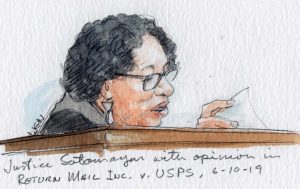A “view” from the courtroom: Return to sender

on Jun 10, 2019 at 4:40 pm

We’re well into June now, and the court enters the morning with 27 outstanding merits cases. It’s beginning to look like a busy final few weeks of the term.
An item in a recent edition of the court’s internal newsletter, Oyez! Oyez!, got me thinking about one of the mind games I played during slower moments of oral arguments this term. The item said “POSTED: applications are being accepted for a cabinetmaker/woodworker in the marshal’s office.”
It’s a reminder that the court has its own woodshop, as it were, presumably to serve the never-ending need for custom furniture of various forms. The notice also makes one wonder whether relevant employees in the building — from the woodworkers to the administrative officers to the justices themselves — have paid any attention to the debate swirling about “court packing,” or expanding the size of the court.
With proposals floated by various advocacy groups and presidential candidates to add as few as two and as many as six justices to the court, there would be some significant practical considerations if any of those proposals became law, however unlikely that is.
Even the addition of two new justices would likely set the court’s woodworkers to work expanding the existing bench on each end. That would push the workspaces of Marshal Pamela Talkin and her assistant, on the right side (looking at the bench), and Clerk Scott Harris and his assistant, on the left, farther to the extreme edges of the available space in the courtroom.
If some of the more radical proposals were enacted, then we would be talking about some serious work in the woodshop. Expanding the court to 15 members would probably require a whole new bench. One possibility is a new, longer version of the current curved bench. Another would involve two rows of benches in the style of some congressional committee rooms. Since there is plenty of room looking up toward the ceiling of the courtroom, perhaps planners should consider a variation of the old “Hollywood Squares” set, with five justices per row stacked in three rows.
The courtroom considerations say nothing of where to put additional chambers. Mark Joseph Stern of Slate floated the idea of a WeWork court, with the most junior justices using offsite workspace until they gain enough seniority to move to traditional chambers.
At 10 a.m., eight of the nine justices serving in the current court — the size authorized by an 1869 act of Congress — take the bench. Justice Stephen Breyer is away on travel, though his voice has been heard in today’s order’s list, with a statement respecting the denial of certiorari in al-Alwi v. Trump, a challenge to the long-term detention of a citizen of Yemen at the U.S. naval base at Guantanamo Bay, Cuba.
Chief Justice John Roberts announces that Justice Brett Kavanaugh has the opinion for the court in Quarles v. United States, which concerns whether for purposes of a violent felony requiring a longer sentence under the Armed Career Criminal Act, a defendant can form the requisite intent to commit burglary any time after entering a building or structure unlawfully.
Kavanaugh explains that this case revolves around “remaining-in burglary,” such as when a person enters a store lawfully but stays after closing and then intentionally steals something.
He explains that the court is rejecting the claims of the petitioner, a Michigan man named Jamar Alonzo Quarles, that remaining-in burglary occurs only when the defendant has the intent to commit a crime at the exact moment he or she first unlawfully remains in a building.
The court sides with the government’s view that remaining-in burglary occurs when the defendant forms the intent to commit a crime at any time while unlawfully present.
“Burglary is dangerous because it creates the possibility of a violent confrontation between the offender and an occupant,” Kavanaugh says from the bench as he delivers a crisp summary of his opinion. For remaining-in burglary, “the possibility of a violent confrontation does not depend on the exact moment when the burglar forms the intent to commit a crime while unlawfully present in a building.”
The opinion is unanimous, with Justice Clarence Thomas filing a concurring opinion.
This case was argued in the unusually busy argument sitting of April. It was one of two, in fact, argued on April 24, the last day for arguments. The other case from that day, Taggart v. Lorenzen, was already decided as well, in a June 2 opinion by Breyer.
Next up is Justice Sonia Sotomayor with the opinion in Return Mail Inc. v. United States Postal Service, stemming from the postal service’s efforts to invalidate a patent for a machine that scans and processes barcodes containing address information, which speeds up the handling of undeliverable mail.
The Feb. 19 argument in this case marked the return of Justice Ruth Bader Ginsburg to the bench after her treatment for lung cancer and a recuperation that required her to be absent for the January argument sitting.
The case presents the question of whether the federal government is a “person” who may petition to institute review proceedings in the U.S. Patent and Trademark Office under a 2011 federal statute, the Leahy-Smith America Invents Act.
Sotomayor summarizes the case, including the three arguments offered on behalf of the postal service that would displace the presumption that a statutory reference to a “person” does not include the government.
“None delivers,” she says of those arguments. It takes a moment for her postal wordplay, which is also in her written opinion, to reach the mental inbox of those in the crowded courtroom, but people begin to chuckle when it does.
“Takes a while, right?” Sotomayor says of the delayed reaction, and she gets a heartier laugh with that.
The ruling below for the government is marked “Return to Sender,” or reversed and remanded. Sotomayor, it turns out, is part of an unusual lineup, joining with the court’s more conservative members in this outcome, while Breyer has written the dissent, joined by Ginsburg and Justice Elena Kagan.
Although the postal service has been declared a non-person, today’s decision cannot detract from the federal agency’s heartwarming role in the landmark case of State of New York v. Kris Kringle (unpublished bench opinion, December 24, 1947), in which the state trial judge took judicial notice of the federal Post Office Department’s (arguably ad hoc) declaration that Mr. Kringle was the one and only Santa Claus. (See “Miracle on 34th Street,” but only the 1947 original in black and white, not the colorized version of that film or the 1994 remake.)
Thomas has the final opinion of the day, in Parker Drilling Management Services Ltd. v. Newton, involving an attempt by a worker on an oil rig off the California coast to be compensated for time on “standby,” a period as long as 12 hours per day when he cannot leave the rig.
Writing for the court, Thomas says that the U.S. Court of Appeals for the 9th Circuit was wrong to hold that California’s wage-and-hour laws, which the worker contends would require that he be paid for standby time, apply. When federal law addresses the relevant issue, state law is not adopted as surrogate federal law on the Outer Continental Shelf, Thomas says.
This spells an end to the worker’s California minimum-wage claims, though Thomas explains that the worker’s other claims were not analyzed by the 9th Circuit, so its decision is vacated and remanded. The opinion is unanimous, and it marks the completion of another case from the April argument sitting.
As the session comes to a close, Talkin announces that we will have to wait until next Monday for delivery of some of the term’s 24 remaining packages.






